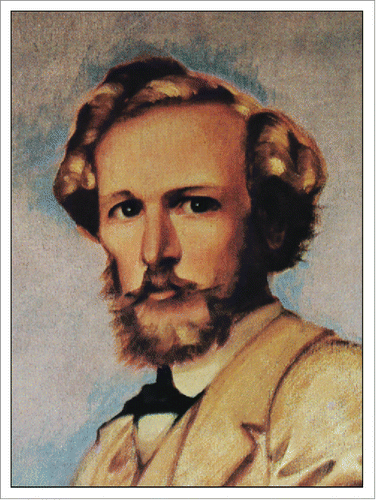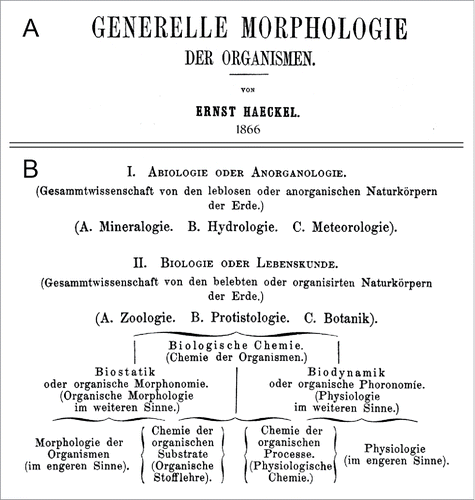ABSTRACT
One hundred and 50 years ago (Sept. 1866), Ernst Haeckel published a monograph entitled General Morphology of Organisms, wherein key terms, such as Protista, Monera, ontogeny, phylogeny, ecology and the ‘biogenetic law’ where introduced. In addition, Haeckel coined the word “biodynamics” as a synonym for “general physiology.” In contrast, Rudolf Steiner's “biodynamic agriculture,” which originated in 1924, and was promoted via Ehrenfried Pfeiffer's book of 1938 with the same title, is an occult pseudoscience still popular today. The misuse of Haeckel's term to legitimize disproven homeopathic principles and esoteric rules within the context of applied plant research is unacceptable.
Introduction
One year ago, the achievements of the botanist Julius Sachs (1832-1897), founder of modern plant physiology, were summarized in this journal.Citation1 In this Addendum, I will outline the content and significance of a 150-year-old book authored by Ernst Haeckel (1834-1919) (), with reference to Sachs' agenda of basic and applied plant research.Citation2
Figure 1. Ernst Haeckel (1834-1919) at around 35 years old. As a young professor at the University of Jena, he wrote his first book, General Morphology of Organisms. Principles of the Organic Morphological Sciences, Mechanically foundet by the Theory of Descent as Introduced by Charles Darwin (1866). Image courtesy of U. Kutschera, private collection.

In a recent Review Article on organic farming in the 21st. century, Reganold and WachterCitation3 argue that “Rudolf Steiner's 1924 course on biodynamic agriculture sparked the evolution of organic agriculture in Europe.” The “biodynamic” (or organic) philosophy is characterized by the authors as an attempt to improve the stability and richness of the soil by enhancing its content of organic matter and avoiding synthetic fertilizers, herbicides and pesticides. However, neither the original meaning of this key term, nor the ideological basis of alternative farming systems, which are rooted in standards set by a system called “biodynamic agriculture,” is mentioned by the authors. Here, I document that the word “biodynamics” originated with Haeckel's book of 1866,Citation4 and that its original meaning was perverted by the founders of the “organic movement” in agriculture.
Haeckel and the biodynamic life sciences
In September 1866, a seminal monograph authored by the German zoologist and evolutionary biologist Ernst Haeckel was published under the title Generelle Morphologie der Organismen (or the General Morphology of Organisms).Citation4 In this 2-Volume-monograph (), Haeckel not only introduced novel terms and concepts, such as Protista, Monera, ontogeny, phylogeny, ecology and the ‘biogenetic law’, but also coined the word “Biodynamik” (biodynamics) as a synonym for ‘general physiology’. Haeckel (1866)Citation4 separated the natural sciences into the major branches I (Abiology or anorganology) and II (Biology or life sciences). In Haeckel's scheme, biology (zoology, protistology and botany) consisted of biostatics (morphology) and biodynamics (physiology) (). In addition, Haeckel (1866)Citation4 published the first “oak tree of life,” wherein the Kingdoms Monera (microorganisms, protists), Animalia (animals), and Plantae (plants) were depicted in an evolutionary context.
Figure 2. Extracts from Ernst Haeckel's General Morphology of Organisms. Original title (A), and classification of the natural sciences (B). In part I, only the headlines are depicted; in part II, dealing with biology or the science of life, the complete original version of Haeckel's scheme is reproduced. Note that the term “Biodynamik” (biodynamics) was introduced as a synonym for physiology in its broadest sense (adapted from ref. 3).

However, Haeckel's book, which was published when the author was just 32 years old, has largely been ignored by the scientific community. As a result, the term “biodynamics” was not adopted by physiologists like Julius Sachs or Wilhelm Pfeffer (1845-1920),Citation1,2 and is even today not widely known. Unfortunately, Haeckel's “bio-word” is well and alive in another context that is unrelated to its original, scientific meaning.
Steiner's occult bio-philosophy
The Austrian philosopher Rudolf Steiner (1861 – 1925) was the leader of an esoteric circle that persists to the present day, notably in Germany and Switzerland. He was also the founder of the oldest, most radical alternative (rule-based) organic agricultural system. Steiner was invited in 1923 by his followers to deliver lectures on how to improve the quality and yield of crops. One year later, his statements (with discussion) were written down and published after Steiner's death under the title Geisteswissenschaftliche Grundlagen zum Gedeihen der Landwirtschaft (or the Spiritual Basis for the Improvement of Agriculture).Citation5
This collection of essays contains rules that his followers obey to in a dogmatic way up to the present. Among other oddities, SteinerCitation5 claimed that, in the long-term, soluble mineral fertilizers cause “a loss in the nutritional value of the crops.” As a result, synthetic mineral salts are prohibited. He also claimed that “cosmic vital forces” have a large impact on physiological processes in plants and animals. For reasons not explained, he recommended to use isolated cow horns as containers to “vitalize” organic and inorganic substances (manure, silica). First, the filled horns must be burrowed below the soil surface.Citation6 A half year later, the “vitalized” content of the recovered cow horn has to be “brought into contact with water.” According to the “biodynamic principle,” the substances have to be “dynamized,” in analogy to the dilution/shaking process of homeopathic practitioners that were invented by the German physician Samuel Hahnemann (1755-1843).Citation7
As recommended by Steiner and his followers, a few grams of the substance (manure or silica) has to be placed into 100 liters of water and stirred by hand for one hour. This “dynamized solution” (in the case of silica, SiO2, without solute) is sprayed on the farm land at a very low rate in order to enhance plant growth and improve the quality of the crops. No statistically significant positive effects have been found even by the followers of this occult practice. However, according to Steiner,Citation5 reproducible results are not necessary; a tendency is enough, because “the truth may reveal itself.”
In 1938, Ehrenfried Pfeiffer (1899-1961), a follower of Steiner's system, popularized these irrational recipes and coined the key term “biological dynamic (or biodynamic) agriculture” (Pfeiffer 1938).Citation8 It is not known whether Pfeiffer, a chemist by profession, was aware of Haeckel's Generelle Morphologie der Organismen (). At any rate, the misuse of a scientific term (Biodynamik, i.e., physiology in its broadest sense) to denote an un-scientific agricultural practice should have been avoided.
Occult biodynamic farming in a leading journal
Are the dogmatic views of SteinerCitation5,6,Citation8 still relevant in present-day bio-organic research? One example may be sufficient to document that they are still alive and well. In a highly cited Science paper by Maeder et al. (2002),Citation9 the rules of the founding fathers of the organic movement have been followed in detail (see ref. 9, Supporting Online Material/special treatments, Table S 1). Steiner's classical “biodynamic preparations P 500 and P 501” (cow-manure and silica, respectively, fermented in a horn) were applied at the “homeopathic” concentrations recommended. However, Maeder et al. (2002)Citation9 did not reveal how Steiner's magic substance SiO2 was “fermented” in the cow horns used in their experiments. They also did not report how many farmers and technicians were employed in order to perform the occult trials described in their paper. According to Steiner, unemployed farmers should be recruited who “will perform this stirring job with joy.” This may be a good idea to lower the high unemployment rate in many European countries. However, it is not the basis for scientific research and an efficient, modern high-yield crop-production system that can feed the growing world population in the years to come. In my opinion, Reganold and WachterCitation3 should have informed their readers about the pseudoscientific basis of organic agriculture, as well as the original meaning of Ernst Haeckel's word “biodynamic,” that was coined 150 years ago.
Conclusions
In this contribution I have documented that Haeckel's term “Biodynamik” has been ignored by physiologists such as Julius Sachs and Wilhelm Pfeffer, who championed plant physiology and its application in agriculture.Citation1,2 However, the founders of the “organic movement,” Rudolf Steiner and his popularizer, Ehrenfried Pfeiffer, used exactly this word in the sense of “dynamization of water,” analogous to homeopathic principles that have been refuted by numerous scientific studies.Citation7 Nevertheless, it should be acknowledged that Steiner was aware of the dangers that may originate from the uncontrolled use of cheap Haber-Bosch synthetic nitrogenous fertilizers.Citation10 Despite this insight, the philosopher, who was not a scientist, mixed up this rational knowledge with his occult anthroposophic ideology.Citation11
There is no question that the aims of organic farming, i.e. avoidance of pollution of air and water by fertilizers and pesticides, maintenance of soil fertility and biodiversity, as well as the production of better-tasting food of superior quality, deserve support by the scientific community. However, as pointed out by Anthony TrewavasCitation12 in an excellent Commentary, in organic farming there is sometimes very little science. Therefore, in articles on this topic, the authorsCitation3 should mention the esoteric roots of the alternative agro-movement – unfortunately, in popular contexts, “organic” and “biodynamic” are used interchangeably.
In my opinion, the future of farming is based on the natural sciences, and not on dogmatic rules and borrowed terms, such as the “biodynamic (i.e., homeopathic) principle” that can be traced back to SteinerCitation5 and Hahnemann.Citation7 Ernst Haeckel () introduced a useful, novel terminology into the emerging biological sciences () that was later misused to distribute occult pseudoscientific principles under the cover of an “alternative” branch of the agricultural sciences.
Disclosure of potential confllicts of interest
No potential conflicts of interest were disclosed.
Acknowledgments
I thank Prof. A. J. Trewavas for helpful comments on the manuscript.
Funding
This project was supported by the Alexander von Humboldt-Foundation (Bonn, Germany) (AvH-Fellowship Stanford, CA, USA, 2015/16 to U. K.).
References
- Kutschera U. Basic versus applied research: Julius Sachs (1832-1897) and the experimental physiology of plants. Plant Signal Behav 2015; 10/9: e1062958
- Kutschera U. Comment: 150 years of an integrative plant physiology. Nature Plants 2015; 1:15131; PMID:27250684; http://dx.doi.org/10.1038/nplants.2015.131
- Reganold JP, Wachter JM. Organic agriculture in the twenty-first century. Nature Plants 2016; 2:15221; PMID:27249193; http://dx.doi.org/10.1038/nplants.2015.221
- Haeckel E. Generelle Morphologie der Organismen. Vol. I–II. G. Reimer, Berlin, 1866
- Steiner R. Geisteswissenschaftliche Grundlagen zum Gedeihen der Landwirtschaft. R. Steiner-Nachlassverwaltung, Dornach, 1929 (8. Ed. 1999)
- Koepf HH, Schaumann W, Haccius M. Biologisch-Dynamische Landwirtschaft. 4. Ed. E. Ulmer, Stuttgart, 1996
- Kutschera U. The difference between Hahnemann and Darwin. Skeptical Inquirer 2008; 32:26-27
- Pfeiffer E. Bio-Dynamic Farming and Gardening: Soil Fertility Renewal and Preservation. Anthroposophic Press, New York, 1938
- Maeder P, Fliessbach A, Dubois D, Gunst L, Fried P, Niggli U. Soil fertility and biodiversity in organic farming. Science 2002; 296:1694-697; PMID:12040197; http://dx.doi.org/10.1126/science.1071148
- Galloway JN, Leach AM, Bleeker A, Erisman JW. A chronology of human understanding of the nitrogen cycle. Phil Trans R Soc Lond B Biol Sci 2013; 368:20130120; http://dx.doi.org/10.1098/rstb.2013.0120
- Paull J. Biodynamic agriculture: the journey from Koberwitz to the world, 1924-1938. J Organic Systems 2011; 6:27-41
- Trewavas A. Urban myths of organic farming. Nature 2001; 410:409-410; PMID:11260685; http://dx.doi.org/10.1038/35068639
